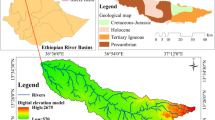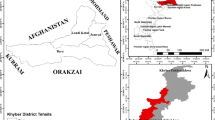Abstract
Land elements like slope, soil depth, land use/land cover, water holding capacity, soil texture, soil erosion, elevation, potential of hydrogen, etc. determine the suitability for agriculture. Land suitability analysis is a one of the methods of assessment of detecting inherent capacities, potential and suitability levels of the lands for agriculture, and was utilized with the same land elements in this study. A multi-criterion decision making approach using IRS P6 LISS-IV satellite dataset within a GIS environment was used to identify suitable areas for agriculture in the Darna catchment. Experts’ opinions, literature review, and correlation technique were used to decide influencing criteria, assign scores to sub-criteria, and judgment formation in pairwise comparison matrix. All thematic layers of criteria were integrated with each other in GIS using the weighted overlay technique and generated agriculture suitability map into four classes according to FAO. About 23% of the area is under agriculture in the study region. This area can extend up to 69% under agriculture converting fallow land, scrub land, and sparse forest according to soil qualities with suitability levels, i.e., highly suitable (19%), moderately suitable (16%), and marginally suitable (34%). About 31% (19,219 ha) of reviewed area are classified in the class permanently “not suitable” for agriculture. Moderately and marginally suitable land requires the irrigation facility for efficient agriculture. This study emphasizes that about 46% area has potential as agriculture land and it will help improve the financial condition of the farmers.











Similar content being viewed by others
References
Akbulak C (2010) Analitik Hiyerarsi surecive cografi bilgi sistemleriile yukarı kara menderes havzasinin arazi kullanimi uygunluk analizi. Uluslararasi Insan Bilimleri Dergisi 7(2):557–576
Akinci H, Ozalp AY, Turgut B (2013) Agriculture land use suitability analysis using GIS and AHP technique. Comput Electron Agric 97:71–82
Bandyopadhyay S, Jaiswal RK, Hegde VS, Jayaraman V (2009) Assessment of land suitability potentials for agriculture using a remote sensing and GIS based approach. Int J Remote Sens 30(4):879–895
Barah BC (2010) Hill agriculture: problems and prospects for mountain agriculture. Indian J Agric Econ 65(3):584–601
Bhagat VS (2012) Use of remote sensing techniques for robust digital change detection of land: a review. Recent Patents on Space Technology 2:123–144
Bhagat VS (2014) Agriculture water balance of micro-watershed using GIS techniques. J Earth Sci Res 2(1):1–12
Bojorquez-Tapia LA, Diaz-Mondragon S, Ezcurra E (2001) GIS-based approach for participatory decision making and land suitability assessment. Int J Geogr Inf Sci 15(2):129–151
Ceballos-Silva A, López-Blanco J (2003a) Evaluating biophysical variables to identify suitable areas for oat in Central Mexico: a multi-criteria and GIS approach. Agric Ecosyst Environ 95:371–377
Ceballos-Silva A, López-Blanco J (2003b) Delineation of suitable areas for crops using a multi-criteria evaluation approach and land use/cover mapping: a case study in Central Mexico. Agric Syst 77:117–136
Cengiz T, Akbulak C (2009) Application of analytical hierarchy process and geographic information systems in land-use suitability evaluation: a case study of Dumrek village. Int J Sust Dev World 16(4):286–294
Census of India (2011) District census handbook, Nashik. Series - 28, Part XII-B
D’haeze D, Deckers J, Raes D, Phong TA, Loi HV (2005) Environmental and socio-economic impacts of institutional reforms on the agricultural sector of Vietnam land suitability assessment for Robusta coffee in the Dak Gan region. Agric Ecosyst Environ 10:59–76
Datye VS, Gupte SC (1984) Association between agricultural land use and physico-socio-economic phenomena: a multivariate approach. Transaction Institute of Indian Geographer 6(2):61–72
Demir M, Yıldız N D˘l, Bulut Y, Yılmaz S, Özer S (2011) Alan Kullanım Planlamasında Potansiyel Tarım Alanlarının Ölçütlerinin Cog˘rafi Bilgi Sistemleri (CBS) Yöntemi ile Belirlenmesi. Ig˘dır Üniversitesi Fen Bilimleri Enstitüsü Dergisi 1(3):77–86
Deshmukh KK, Aher SP (2016) Assessment of the impact of municipal solid waste on groundwater quality near the Sangamner City using GIS approach. Water Resour Manag 30:2425–2443. https://doi.org/10.1007/s11269-016-1299-5
Duc T (2006) Using GIS and AHP technique for land-use suitability analysis, International symposium on geo-informatics for spatial infrastructure development in earth and allied sciences, organized by Japan-Vietnam geo-informatics consortium institute for environment and resources, Vietnam. Polytechnic University of Hochiminh City, Vietnam
Dumanski J (1997) Criteria and indicators for land quality and sustainable land management. ITC J 3(4):216–222
Elsheikh R, Abdul RB, Shariff M, Amiri F, Ahmad NB, Balasundram S, Soom M (2013) Agriculture land suitability evaluator (ALSE): a decision and planning support tool for tropical and sub-tropical crops. Comput Electron Agric 93:98–110
FAO (2006) Fertilizer and plant nutrition.. Food and Agriculture Organization of the United Nations, Rome, Italy. bulletin 16
FAO, WFP and IFAD (2012) The state of food insecurity in the world 2012. Economic growth is necessary but not sufficient to accelerate reduction of hunger and malnutrition. Rome, Italy
Feizizadeh B, Blaschke T (2012) Land suitability analysis for Tabriz County, Iran: a multi-criteria evaluation approach using GIS. J Environ Plan Manag 1:1–23
Foshtomi MD, Norouzi M, Rezaei M, Akef M, Akbarzadeh A (2011) Qualitative and economic land suitability evaluation for tea in sloping area of Guilan, Iran. J Biol Environ Sci 5(15):135–146
Garcia JL, Alvarado A, Blanco J, Jimenez E, Maldonado AA, Cortés G (2014) Multi-attribute evaluation and selection of sites for agricultural product warehouses based on an analytic hierarchy process. Comput Electron Agric 100:60–69
Iqbal M, Khan I (2014) Spatiotemporal land use land cover change analysis and erosion risk mapping of Azad Jammu and Kashmir, Pakistan. Egypt J Remote Sens Space Sci 17:209–229
Jafari S, Zaredar N (2010) Land suitability analysis using multi attribute decision making approach. Int J Environ Sci Dev 1(5):441–445
Jankowski P (1995) Integrating geographical information system and multiple criteria decision making methods. Int J Geogr Inf Syst 9(3):251–273
Jin XM, Zhang YK, Schaepman ME, Clevers JGPW, Su Z (2008) Impact of elevation and aspect on the spatial distribution of vegetation in the Qilian mountain area with remote sensing data. Int Arch Photogramm Remote Sens Spat Inf Sci 37(B7):1385–1390
Joerin F, Theriault M, Musy A (2001) Using GIS and outranking multi-criteria analysis for land-use suitability assessment. Int J Geogr Inf Sci 15(2):153–174
Kalogirou S (2002) Expert systems and GIS: an application of land suitability evaluation. Comput Environ Urban Syst 26:89–112
Kauko T (2006) What makes a location attractive for the housing consumer? Preliminary findings from metropolitan Helsinki and Randstad Holland using the analytical hierarchy process. J Housing Built Environ 21(2):159–176
Krishnamurthy J (1997) The evaluation of digitally enhanced Indian remote sensing satellite ( IRS) data for lithological and structural mapping. Int J Remote Sens 18(16):3409–3437
Lunetta RS, Elvidge CD (1998) Remote sensing change detection. Ann Arbor press, Michigan
Malczewski J (1999) GIS and multi-criteria decision analysis. John Wiley and Sons Inc., New York
Malczewski J (2004) GIS-based land suitability: a critical overview. Prog Plan 62:3–65
Malczewski J (2006) GIS-based multi-criteria decision analysis: a survey of the literature. Int J Geogr Inf Sci 20(7):703–726
Mendas A, Delali A (2012) Integration of multi-criteria decision analysis in GIS to develop land suitability for agriculture: application to durum wheat cultivation in the region of Mleta in Algeria. Comput Electron Agric 83:117–126
Miller W, Collins W, Steiner FR, Cook E (1998) An approach for greenway suitability analysis landscape and urban planning. Int J Geogr Inf Sci 42(2–4):91–105
Mojid MA, Mustafa SMT, Wyseure GCL (2009) Growth, yield and water use efficiency of wheat in silt loam-amended loamy sand. J Bangladesh Agric Univ 7(2):403–410
Mokarram M, Aminzadeh F (2010) GIS-based multi-criteria land suitability evaluation using ordered weight averaging with fuzzy quantifier: a case study in Shavur plain Iran. Int Arch Photogramm Remote Sens Spat Inf Sci 38(2):508–512
Mustafa AA, Singh M, Sahoo RN, Ahmed N, Khanna M, Sarangi A (2011) Land suitability analysis for different crops: a multi-criteria decision making approach using remote sensing and GIS. Researcher 3(12):61–84
Olayeye AO, Akinbols GE, Marake VM, Molete SF, Mapheshoane B (2008) Soil in suitability evaluation for irrigated lowland rice culture in South-Western Nigeria: management implications for sustainability. Commun Soil Sci Plant Anal 39:2920–2938
Perveen F, Ryota N, Imtiaz U, Hossain KMD (2007) Crop land suitability analysis using a MCE and GIS approach. 5th international symposium on digital earth. University of California, Berkeley, pp 1–8
Prakash TN (2003) Land suitability analysis for agricultural crops: a fuzzy multi-criteria decision making approach. M.sc thesis. The International Institute for geo-information Science and Earth Observation (ITC), Enschede, The Netherlands, pp 6–13
Rabia AH (2012) Mapping soil erosion risk using rusle, GIS and remote sensing techniques. In: The 4th international congress of ECSSS, EUROSOIL. Bari, Italy
Rabia AH, Terribile F (2013) Introducing a new parametric concept for land suitability assessment. Int J Environ Sci Dev 4(1):15–19
Ravi S, Breshears DD, Huxman TE, D'Odorico P (2010) Land degradation in drylands: interactions among hydrologic-aeolian erosion and vegetation dynamics. Geomorphology 116:236–245
Saaty TL (1980) The analytic hierarchy process: planning, priority setting, resource allocation. McGraw Hill International, New York
Saaty TL (1997) A scaling method for priorities in hierarchical structures. J Math Psychol 15:234–281
Sarkar A, Ghosh A, Banik P (2014) Multi-criteria land evaluation for suitability analysis of wheat: a case study of a watershed in eastern plateau region, India. Geo-spatial Information Science 17(2):119–128
Shalaby A, Ouma YO, Tateishi R (2006) Land suitability assessment for perennial crops using remote sensing and geographic information systems: a case study in North-Western Egypt. Arch Agron Soil Sci 52(3):243–261
Soltani SR, Mahiny AS, Monavari SM, Alesheikh AA (2012) A soft approach to conflict resolution in multi-criteria evaluation of urban land use suitability. World Appl Sci J 19(7):1066–1077
Srdjevic Z, Kolarov V, Srdjevic B (2007) Finding the best location for pumping stations in the Galovica drainage area of Serbia: the AHP approach for sustainable development. Bus Strateg Environ 16(7):502–511
Steiner F, McSherry L, Cohen J (2000) Land suitability analysis for the upper Gila river watershed. Landsc Urban Plan 50:199–214
Thompsion LM, Troeh FR (1973) Soils and soil fertility. McGraw-Hill Publications in the Agriculture Sciences
Wang F (1994) The use of artificial neural networks in a geographical information system for agricultural land-suitability assessment. Environ Plan A 26(2):265–284
Wang F, Hall GB, Subaryono (1990) Fuzzy information representation and processing in conventional GIS software: data base design and applications. Int J Geogr Inf Syst 4(3):261–283
WMO (2005) Climate and land degradation. World Meteorological Organization (WMO) Publication No. 989. Available online at http://www.wmo.int. Accessed 14 March 2014
Yalew SG, Griensven A, Mul ML, Zaag P (2016a) Land suitability analysis for agriculture in the Abbay basin using remote sensing, GIS and AHP techniques. Model Earth Syst Environ 101:1–14. https://doi.org/10.1007/s40808-016-0167-x
Yalew SG, Griensven A, Zaag P (2016b) AgriSuit: a web-based GIS-MCDA framework for agricultural land suitability assessment. Comput Electron Agric 128:1–8
Zolekar RB, Bhagat VS (2014) Use of IRS P6 LISS-IV data for land suitability analysis for cashew plantation in hilly zone. Asian Journal of Geoinformatics 14(3):23–35
Zolekar RB, Bhagat VS (2015) Multi-criteria land suitability analysis for agriculture in hilly zone: remote sensing and GIS approach. Comput Electron Agric 118-C:300–321
Acknowledgements
I would like to thank the Principal and Management of K.V.N. Naik Shikshan Prasarak Sanstha, Nashik for encouraging me to complete this research work. The author wishes to thank the anonymous reviewers for their thorough reviews. I would like to thank to Dr. Vijay Bhagat, Dr. Bharat Gadakh, Prof. Arjun Doke, and Dr. Santosh Bhailume for their genuine help during this research work and also thankful to the Department of Geography, K.T.H.M. College Nashik (Maharashtra, India) using Geo-informatics lab for data processing. Further, Prof. Dilip Kute and Dr. Sanjay Sanap are also thanked for language correction.
Author information
Authors and Affiliations
Corresponding author
Rights and permissions
About this article
Cite this article
Zolekar, R.B. Integrative approach of RS and GIS in characterization of land suitability for agriculture: a case study of Darna catchment. Arab J Geosci 11, 780 (2018). https://doi.org/10.1007/s12517-018-4148-4
Received:
Accepted:
Published:
DOI: https://doi.org/10.1007/s12517-018-4148-4




